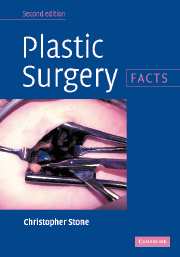Book contents
- Frontmatter
- Contents
- List of Abbreviations
- Preface
- 1 Cutaneous neoplasia and hamartomas (BCC, SCC, melanoma, vascular malformations, sarcomas)
- 2 Principles of plastic surgery (local and free flaps, skin grafts, wound healing)
- 3 Hypospadias (embryology, anatomy and clinical management of hypospadias)
- 4 Cleft surgery (embryology, anatomy and management of cleft lip, palate, pharyngoplasty, orthodontics)
- 5 Hand surgery (trauma, degenerative and inflammatory disease, nerve compression, congenital abnormalities)
- 6 Burns (pathophysiology and acute and long-term management)
- 7 Breast surgery (cosmetic breast surgery, reconstruction, reconstruction of abdomen and perineum)
- 8 Head and neck oncology and reconstruction, facial reanimation, maxillofacial trauma, craniofacial surgery
- 9 Cosmetic surgery (lasers, facelift, chemical peel, dermabrasion, liposuction, abdominoplasty, rhinoplasty, botulinum toxin)
- 10 Miscellaneous (lower limb trauma, pressure sores, lymphoedema, VAC therapy, tissue expansion)
- Index
- References
9 - Cosmetic surgery (lasers, facelift, chemical peel, dermabrasion, liposuction, abdominoplasty, rhinoplasty, botulinum toxin)
Published online by Cambridge University Press: 12 November 2009
- Frontmatter
- Contents
- List of Abbreviations
- Preface
- 1 Cutaneous neoplasia and hamartomas (BCC, SCC, melanoma, vascular malformations, sarcomas)
- 2 Principles of plastic surgery (local and free flaps, skin grafts, wound healing)
- 3 Hypospadias (embryology, anatomy and clinical management of hypospadias)
- 4 Cleft surgery (embryology, anatomy and management of cleft lip, palate, pharyngoplasty, orthodontics)
- 5 Hand surgery (trauma, degenerative and inflammatory disease, nerve compression, congenital abnormalities)
- 6 Burns (pathophysiology and acute and long-term management)
- 7 Breast surgery (cosmetic breast surgery, reconstruction, reconstruction of abdomen and perineum)
- 8 Head and neck oncology and reconstruction, facial reanimation, maxillofacial trauma, craniofacial surgery
- 9 Cosmetic surgery (lasers, facelift, chemical peel, dermabrasion, liposuction, abdominoplasty, rhinoplasty, botulinum toxin)
- 10 Miscellaneous (lower limb trauma, pressure sores, lymphoedema, VAC therapy, tissue expansion)
- Index
- References
Summary
Aesthetic breast surgery (see Chapter 7)
Laser surgery
Grabb and Smith, Lasers in Plastic Surgery; Achauer. PRS 1997
1916 – Einsteins's theory of stimulated emission of radiation
1950s – Schawlow and Townes: microwave amplification by stimulation emission of radiation (MASER)
1957 – Maiman: light amplification by stimulated emission of radiation (LASER) using a synthetic ruby crystal
Helium neon laser, Nd:YAG, CO2 and argon lasers all developed in the early 1960s
Components of a laser:
energy source
electricity (argon laser)
flashlamp (pulsed dye laser)
another laser (CO2 laser)
laser medium – solid or gas
laser cavity (resonator)
Laser medium is energized to excite electrons into a higher energy state (unstable orbit around the nucleus, ‘singlet state’)
As electrons move back into a stable orbit (via a ‘metastable state’) a photon of light is emitted, i.e. spontaneous emission
Generation of photons then perpetuates the movement of electrons of other atoms back into a stable orbit → more photons, i.e. stimulated emission
Photons move randomly in the resonator but emerge through a pair of mirrors (one partially reflective) to become a parallel or collimated laser beam with all the same wavelength
Longer wavelength → better penetration
Energy (J) ∝ number of photons
Power = energy s− 1, i.e. rate of delivery of energy (W)
1 W = 1 J s− 1
rate of input of energy to create the laser beam
Irradiance = power per unit area (W/cm2)
Fluence = energy cm− 2 (J cm− 2)
Gaussian distribution of heat within the spot – 10% overlap is not harmful
Absorption coefficient of tissues also determines penetration
Continuous wave lasers may be broken intermittently by a mechanical shutter to form a pulsed wave (pulsed-dye laser)
[…]
- Type
- Chapter
- Information
- Plastic SurgeryFacts, pp. 474 - 512Publisher: Cambridge University PressPrint publication year: 2006



